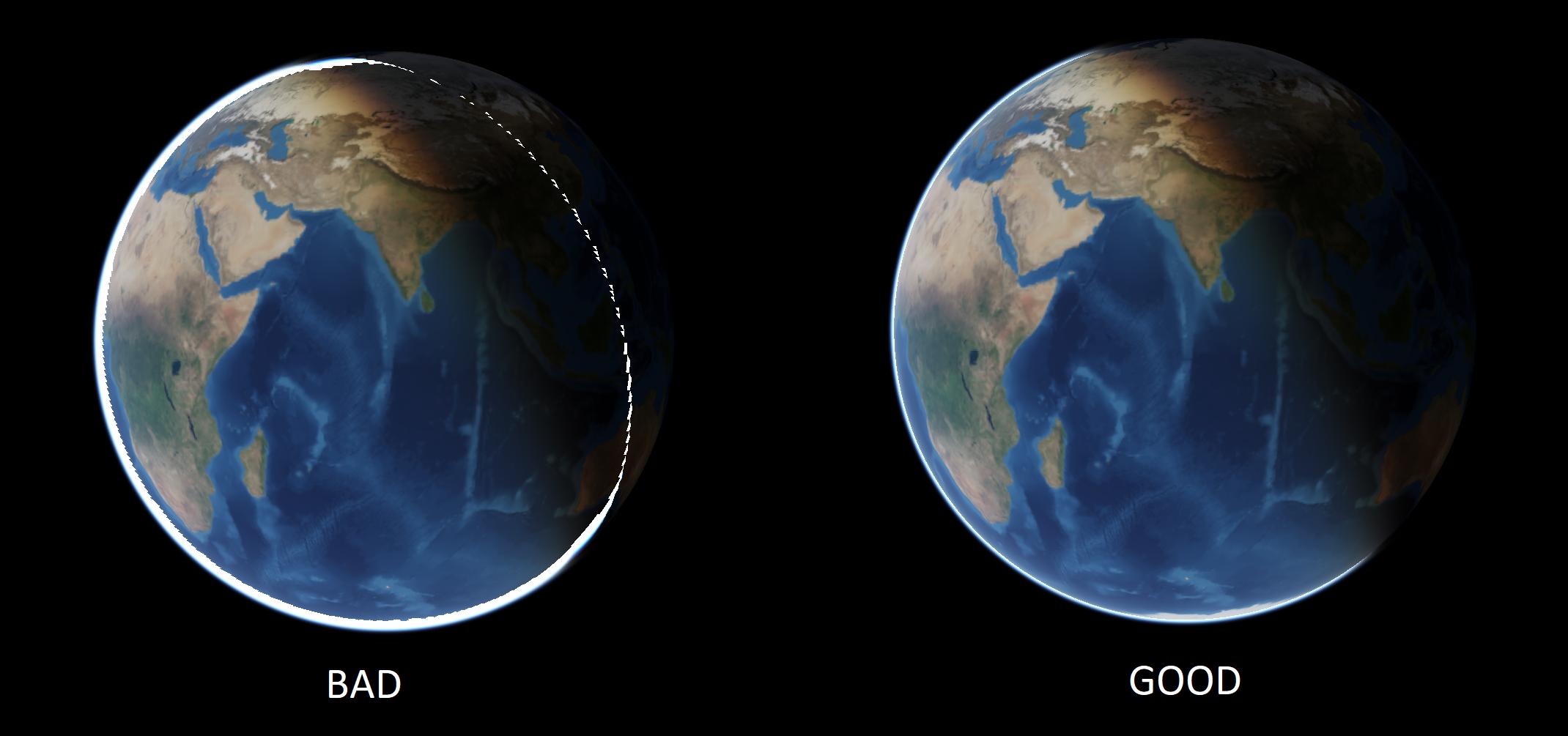我正在尝试使用离屏帧缓冲区来复制可以完美渲染到默认帧缓冲区的场景。渲染中似乎存在差异,我无法解决。
作为上下文,我使用大气着色器来可视化地球。我使用的是 QT QOpenGLWidget,但主要是原始 GL 调用,因为我不喜欢 QT 的抽象。我需要将此场景渲染到离屏帧缓冲区,因为我想在可视化中实现一些后处理效果,为此我需要能够将场景采样为纹理。我已经成功创建了一个帧缓冲区并将其颜色纹理渲染到屏幕上的四边形。
我的理解是,与默认情况下渲染到离屏帧缓冲区时,Alpha 混合的行为有所不同。我无法在网上找到任何资源来表明无需重大重构即可产生相同结果的方法。我见过的方法包括按照从后到前的顺序手动渲染对象,或者将 alpha 值烘焙到发送到帧缓冲区的颜色。我尝试了一种经常建议的替代方案,即使用 glBlendFuncSeparate 来更手动地控制:
glEnable(GL_BLEND);
glBlendFuncSeparate(GL_SRC_ALPHA, GL_ONE_MINUS_SRC_ALPHA, GL_ONE, GL_ONE_MINUS_SRC_ALPHA);
但这并没有给我的结果带来任何明显的改善(我也不期望如此,因为这里的数学无法解决我所看到的混合问题)。
废话已经够多了,现在开始讲一些实际的代码。我的代码库非常庞大,因此不幸的是我无法共享所有代码,因为有许多专有的绘图例程,但我可以从如何生成帧缓冲区开始:
// Create the framebuffer object
glGenFramebuffers(1, &m_fbo);
// Bind the framebuffer to the current context
glBindFramebuffer(GL_FRAMEBUFFER, m_fbo);
// generate texture to attach as a color attachment to the current frame buffer
m_texColorUnit = 4;
// Set to width and height of window, and leave data uninitialized
glGenTextures(1, &m_texColorBuffer);
glActiveTexture(GL_TEXTURE0 + m_texColorUnit);
glBindTexture(GL_TEXTURE_2D, m_texColorBuffer);
glTexImage2D(GL_TEXTURE_2D,
0,
GL_RGB8_OES,
m_navigation->renderContext()->getWidth(),
m_navigation->renderContext()->getHeight(),
0,
GL_RGB8_OES,
GL_UNSIGNED_BYTE,
NULL);
glTexParameteri(GL_TEXTURE_2D, GL_TEXTURE_MIN_FILTER, GL_LINEAR);
glTexParameteri(GL_TEXTURE_2D, GL_TEXTURE_MAG_FILTER, GL_LINEAR);
// attach texture to currently bound framebuffer object
glFramebufferTexture2D(GL_FRAMEBUFFER,
GL_COLOR_ATTACHMENT0,
GL_TEXTURE_2D,
m_texColorBuffer,
0);
glBindTexture(GL_TEXTURE_2D, 0); //unbind the texture
glActiveTexture(GL_TEXTURE0); // Reset active texture to default
// Create renderBuffer object for depth and stencil checking
glGenRenderbuffers(1, &m_rbo);
glBindRenderbuffer(GL_RENDERBUFFER, m_rbo); // bind rbo
glRenderbufferStorage(GL_RENDERBUFFER,
GL_DEPTH24_STENCIL8_OES,
m_navigation->renderContext()->getWidth(),
m_navigation->renderContext()->getHeight()
); // allocate memory
// Attach rbo to the depth and stencil attachment of the fbo
glFramebufferRenderbuffer(GL_FRAMEBUFFER,
GL_DEPTH_STENCIL_OES,
GL_RENDERBUFFER,
m_rbo);
还有气氛的着色器:
// vert
#ifndef GL_ES
precision mediump int;
precision highp float;
#endif
attribute vec3 posAttr;
uniform highp mat4 matrix;
uniform highp mat4 modelMatrix;
uniform vec3 v3CameraPos; // The camera's current position
uniform vec3 v3LightPos; // The direction vector to the light source
uniform vec3 v3InvWavelength; // 1 / pow(wavelength, 4) for the red, green, and blue channels
uniform float fCameraHeight; // The camera's current height
uniform float fCameraHeight2; // fCameraHeight^2
uniform float fOuterRadius; // The outer (atmosphere) radius
uniform float fOuterRadius2; // fOuterRadius^2
uniform float fInnerRadius; // The inner (planetary) radius
uniform float fInnerRadius2; // fInnerRadius^2
uniform float fKrESun; // Kr * ESun
uniform float fKmESun; // Km * ESun
uniform float fKr4PI; // Kr * 4 * PI
uniform float fKm4PI; // Km * 4 * PI
uniform float fScale; // 1 / (fOuterRadius - fInnerRadius)
uniform float fScaleDepth; // The scale depth (i.e. the altitude at which the atmosphere's average density is found)
uniform float fScaleOverScaleDepth; // fScale / fScaleDepth
const int nSamples = 5;
const float fSamples = 5.0;
varying vec3 col;
varying vec3 colatten;
varying vec3 v3Direction;
varying vec3 vertexWorld;
float scale(float fCos)
{
float x = 1.0 - fCos;
return fScaleDepth * exp(-0.00287 + x*(0.459 + x*(3.83 + x*(-6.80 + x*5.25))));
}
void main(void)
{
// Get the ray from the camera to the vertex and its length (which is the far point of the ray passing through the atmosphere)
vec3 v3Pos = posAttr;
vec3 vertexWorld = posAttr;
vec3 v3Ray = v3Pos - v3CameraPos;
float fFar = length(v3Ray);
v3Ray /= fFar;
// Calculate the closest intersection of the ray with the outer atmosphere (which is the near point of the ray passing through the atmosphere)
float B = 2.0 * dot(v3CameraPos, v3Ray);
float C = fCameraHeight2 - fOuterRadius2;
float fDet = max(0.0, B*B - 4.0 * C);
float fNear = 0.5 * (-B - sqrt(fDet));
// Calculate the ray's starting position, then calculate its scattering offset
vec3 v3Start = v3CameraPos + v3Ray*fNear;
fFar -= fNear;
float fStartAngle = dot(v3Ray, v3Start) / fOuterRadius;
float fStartDepth = exp(-1.0 / fScaleDepth);
float fStartOffset = fStartDepth*scale(fStartAngle);
// Initialize the scattering loop variables
float fSampleLength = fFar / fSamples;
float fScaledLength = fSampleLength * fScale;
vec3 v3SampleRay = v3Ray * fSampleLength;
vec3 v3SamplePoint = v3Start + v3SampleRay * 0.5;
// Now loop through the sample rays
vec3 v3FrontColor = vec3(0.0, 0.0, 0.0);
for(int i=0; i<nSamples; i++)
{
float fHeight = length(v3SamplePoint);
float fDepth = exp(fScaleOverScaleDepth * (fInnerRadius - fHeight));
float fLightAngle = dot(v3LightPos, v3SamplePoint) / fHeight;
float fCameraAngle = dot(v3Ray, v3SamplePoint) / fHeight;
float fScatter = (fStartOffset + fDepth*(scale(fLightAngle) - scale(fCameraAngle)));
vec3 v3Attenuate = exp(-fScatter * (v3InvWavelength * fKr4PI + fKm4PI));
v3FrontColor += v3Attenuate * (fDepth * fScaledLength);
v3SamplePoint += v3SampleRay;
}
// Finally, scale the Mie and Rayleigh colors and set up the varying variables for the pixel shader
colatten = v3FrontColor * fKmESun;
col = v3FrontColor * (v3InvWavelength*fKrESun);
v3Direction = v3CameraPos - v3Pos;
gl_Position = matrix * modelMatrix * vec4(posAttr,1);
}
// frag
#ifdef GL_ES
precision highp float;
precision mediump int;
#endif
varying vec3 col;
varying vec3 colatten;
varying vec3 v3Direction;
varying vec3 vertexWorld;
uniform vec3 v3LightPos;
uniform float g;
uniform float g2;
uniform float fExposure;
void main (void)
{
//float fCos = dot(normalize(lPos), normalize(v3Direction));
float fCos = dot(v3LightPos, v3Direction) / length(v3Direction);
float fRayleighPhase = 0.75 * (1.0 + fCos*fCos);
float fMiePhase = 1.5 * ((1.0 - g2) / (2.0 + g2)) * (1.0 + fCos*fCos) / pow(1.0 + g2 - 2.0*g*fCos, 1.5);
//vec3 result = clamp(col + fMiePhase * colatten, vec3(0,0,0), vec3(1,1,1));
//gl_FragColor = vec4(result, result.b);
gl_FragColor.rgb = 1.0 - exp(-fExposure * (fRayleighPhase * col + fMiePhase * colatten));
//gl_FragColor.a = 1.0;
gl_FragColor.a = gl_FragColor.b;
}
正如我所说,我的成绩并不理想。  第一个图像是我渲染到离屏帧缓冲区时得到的图像,第二个图像是我直接渲染到屏幕时得到的图像。关于如何解决这两个问题有什么想法吗?
第一个图像是我渲染到离屏帧缓冲区时得到的图像,第二个图像是我直接渲染到屏幕时得到的图像。关于如何解决这两个问题有什么想法吗?
最佳答案
深度渲染缓冲区未附加到帧缓冲区。 glFramebufferRenderbuffer的第二个参数必须是连接点。
GL_DEPTH_STENCIL_OES 不是附着点的有效值。所以
glFramebufferRenderbuffer(GL_FRAMEBUFFER, GL_DEPTH_STENCIL_OES, GL_RENDERBUFFER, m_rbo);
会导致GL_INVALID_ENUM错误,可以通过glGetError得到.
指定深度和模板缓冲区的枚举器常量是GL_DEPTH_STENCIL_ATTACHMENT:
glFramebufferRenderbuffer(GL_FRAMEBUFFER,
GL_DEPTH_STENCIL_ATTACHMENT,
GL_RENDERBUFFER,
m_rbo);
请注意,深度/模板缓冲区未附加到帧缓冲区,但帧缓冲区仍然完整,没有深度和模板缓冲区。
或者,您可以使用仅深度缓冲区附件。创建深度渲染缓冲区 (GL_DEPTH_COMPONENT),并使用附件类型 GL_DEPTH_ATTACHMENT。
导致此问题的原因是附加到帧缓冲区颜色平面的纹理没有 Alpha channel 。 GL_RGB8_OES 格式提供 3 个颜色 channel (RGB),但没有 Alpha channel 。
glTexImage2D(GL_TEXTURE_2D, 0, GL_RGB8_OES, m_navigation->renderContext()->getWidth(), m_navigation->renderContext()->getHeight(), 0, GL_RGB8_OES, GL_UNSIGNED_BYTE, NULL);
您必须使用格式和内部格式 GL_RGBA8_OES 而不是 GL_RGB8_OES,它包含在 OES_required_internalformat 中。 , 也。另请参阅__gles2_gl2ext_h_ :
glTexImage2D(GL_TEXTURE_2D,
0,
GL_RGBA8_OES,
m_navigation->renderContext()->getWidth(),
m_navigation->renderContext()->getHeight(),
0,
GL_RGBA8_OES,
GL_UNSIGNED_BYTE,
NULL);
关于c++ - 如何克服屏幕外和屏幕上帧缓冲区渲染之间的差异?,我们在Stack Overflow上找到一个类似的问题: https://stackoverflow.com/questions/56503276/